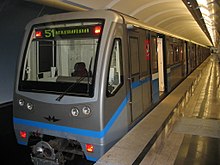There are two systems which are called LRT in Malaysia. Two are used in Kuala Lumpur to ferry paying passengers while the automated people mover is used at Kuala Lumpur International Airport to ferry passengers from the Main Terminal Building and the satellite building.
The two light metro or light rapit transit lines in Kuala Lumpur are the Kelana Jaya Line and the Ampang Line. The Kelana Jaya Line is a driver-less automatic system and is 29 km (18 mi) long, running between the northeastern suburbs of Kuala Lumpur and Petaling Jaya to the west of Kuala Lumpur. It is mostly elevated except for a 4 km (2.5 mi) stretch where it goes underground and there is a short at-grade stretch. The Kelana Jaya Line was completely operational from June 1999. The older Ampang Line is 27 km (17 mi) and consists of two sub-lines, running between the suburb of Sentul in the north of Kuala Lumpur, and Ampang in the east, as well as Sri Petaling in the south. Trains branch off to either Ampang or Sri Petaling at Chan Sow Lin station about midway of both lines. The system is mostly at-grade outside the city, and elevated with it runs through the city. Unlike the trains on the Kelana Jaya Line, those on the Ampang Line have drivers. The line was completely opened on 1998.
The automated people mover system at Kuala Lumpur International Airport, called the "Aerotrain", is a simple people-mover shuttle system running along two 1,286 m (4,219 ft) guiderails between the Main Terminal Building and Satellite Building. The two ends of the guiderails are elevated while the middle portion goes under the main airport taxiway. Each rail has a three-car automatic driver-less train.






